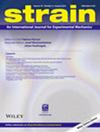混凝土压缩变形本构方程的确定及动态数值模拟
IF 1.8
3区 材料科学
Q2 MATERIALS SCIENCE, CHARACTERIZATION & TESTING
引用次数: 0
摘要
采用有限元(FE)、无单元伽辽金(EFG)和光滑颗粒伽辽金(SPG)方法对室内浇筑混凝土(平均骨料尺寸为2-2.5 mm)的动态压缩变形进行建模,以确定它们捕捉动态变形的能力。数值计算结果与霍普金森压杆劈裂试验结果吻合较好。EFG法和FE法均高估了破坏应力和应变值,而SPG法低估了峰值应力。SPG表现出与实验相似的承载能力分布图。在加载的初始阶段,所有的方法都表现出相似的行为。尽管如此,随着加载的继续,SPG方法预测的变形剖面和力历史更接近一致。在高应变速率下强度的增加是由于速率敏感性和约束效应引起的侧向惯性。材料的惯性效应在较低应变值下尤其有效,而混凝土的应变率敏感性在较高应变值下变得显著。本文章由计算机程序翻译,如有差异,请以英文原文为准。
Constitutive equation determination and dynamic numerical modelling of the compression deformation of concrete
The dynamic compression deformation of an in‐house cast concrete (average aggregate size of 2–2.5 mm) was modelled using the finite element (FE), element‐free Galerkin (EFG) and smooth particle Galerkin (SPG) methods to determine their capabilities of capturing the dynamic deformation. The numerical results were validated with those of the experimental split Hopkinson pressure bar tests. Both EFG and FE methods overestimated the failure stress and strain values, while the SPG method underestimated the peak stress. SPG showed similar load capacity profile with the experiment. At initial stages of the loading, all methods present similar behaviour. Nonetheless, as the loading continues, the SPG method predicts closer agreement of deformation profile and force histories. The increase in strength at high strain rate was due to both the rate sensitivity and lateral inertia caused by the confinement effect. The inertia effect of the material especially is effective at lower strain values and the strain rate sensitivity of the concrete becomes significant at higher strain values.
求助全文
通过发布文献求助,成功后即可免费获取论文全文。
去求助
来源期刊

Strain
工程技术-材料科学:表征与测试
CiteScore
4.10
自引率
4.80%
发文量
27
期刊介绍:
Strain is an international journal that contains contributions from leading-edge research on the measurement of the mechanical behaviour of structures and systems. Strain only accepts contributions with sufficient novelty in the design, implementation, and/or validation of experimental methodologies to characterize materials, structures, and systems; i.e. contributions that are limited to the application of established methodologies are outside of the scope of the journal. The journal includes papers from all engineering disciplines that deal with material behaviour and degradation under load, structural design and measurement techniques. Although the thrust of the journal is experimental, numerical simulations and validation are included in the coverage.
Strain welcomes papers that deal with novel work in the following areas:
experimental techniques
non-destructive evaluation techniques
numerical analysis, simulation and validation
residual stress measurement techniques
design of composite structures and components
impact behaviour of materials and structures
signal and image processing
transducer and sensor design
structural health monitoring
biomechanics
extreme environment
micro- and nano-scale testing method.
 求助内容:
求助内容: 应助结果提醒方式:
应助结果提醒方式:


